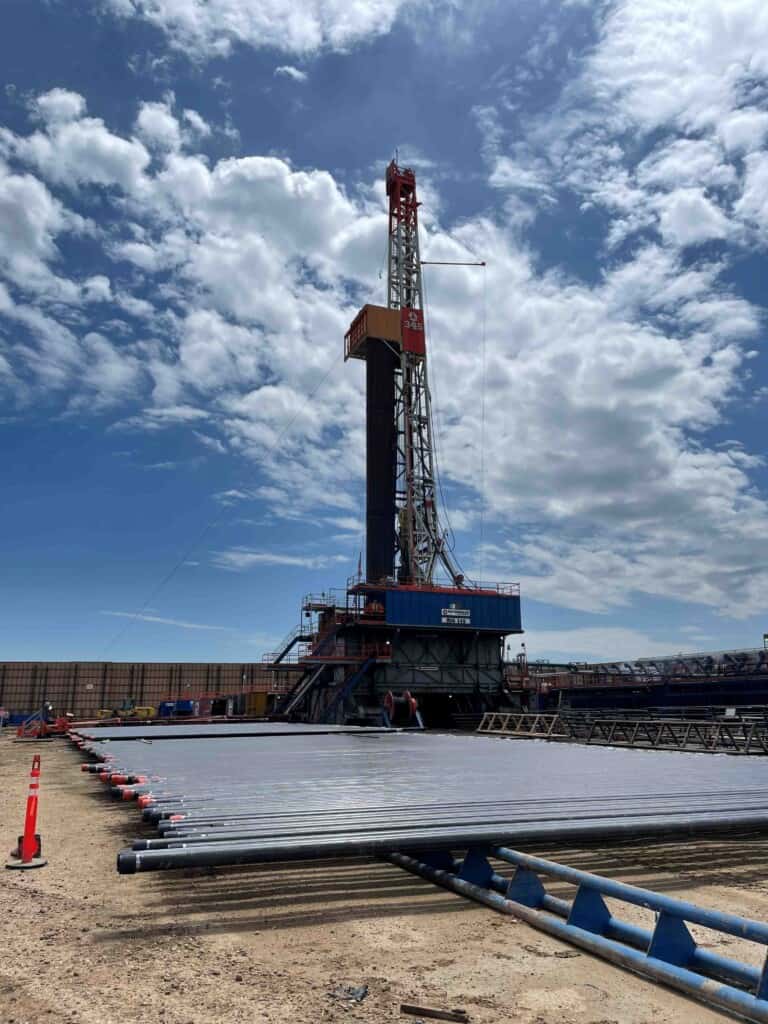The exploration and drilling phases of geothermal projects have specific environmental concerns that are distinct from the operational phases of these projects. Potential exploration and development concerns may include water (for example, water quantity use, groundwater contamination, disposal, and remediation), induced seismicity, and land subsidence caused mainly by fluid withdrawal. Let’s take a look at each of these concerns, starting with the drilling phase.1Beard, J.C., and Jones, B.A., eds. (2023, May 1). Chapter 10: Environmental Considerations and Impact. The Future of Geothermal in Texas. p. 265. https://energy.utexas.edu/research/geothermal-texas
Techniques and approaches used for drilling wells are almost identical whether the wells are for a geothermal or oil and gas program. Some variations may occur, depending upon the particular geothermal concept. Well drilling requires water and (commonly) some type of bentonite-rich additive that increases viscosity enough to return drill cuttings to the surface.2Beard, J.C., and Jones, B.A., eds. (2023, May 1). Chapter 10: Environmental Considerations and Impact. The Future of Geothermal in Texas. p. 265. https://energy.utexas.edu/research/geothermal-texas To find out more about drilling engineering and technology, you can visit our course “In Pursuit of the Safe Well”.

Whether the application is geothermal or oil and gas, drilling processes require a number of necessary environmental considerations, for example, identifying a water source with sufficient volumes, managing fluids with potentially dissolved contaminants or cuttings, and ensuring that local groundwater resources are not impacted by the drilling and completion processes.3Beard, J.C., and Jones, B.A., eds. (2023, May 1). Chapter 10: Environmental Considerations and Impact. The Future of Geothermal in Texas. p. 265. https://energy.utexas.edu/research/geothermal-texas The oil and gas industry has decades of experience in addressing these environmental considerations related to drilling, and state regulatory agencies have numerous rules and inspectors in place to oversee these operations. However, if geothermal programs increase in number to the scale of the oil and gas industry, clearly large numbers of personnel will be needed for the geothermal workforce of the future.
Water and Fluid Management
According to the U.S. Energy Information Agency, nearly 1,000,000 oil and gas production wells are in operation today, and many more have been drilled over the last 100 years, each of these wells required water for drilling.4Beard, J.C., and Jones, B.A., eds. (2023, May 1). Chapter 10: Environmental Considerations and Impact. The Future of Geothermal in Texas. p. 265. https://energy.utexas.edu/research/geothermal-texas
Experience from Oil and Gas Wells
A more recent history of horizontal drilling indicates that the volume of water used for drilling and cementing oil and gas wells is about 380,000 gallons per well.5Scanlon, B. R., Reedy, R. C., & Nicot, J. P. (2014). Comparison of water use for hydraulic fracturing for unconventional oil and gas versus conventional oil. Environmental science & technology, 48(20), 12386-12393. If the well were to require hydraulic stimulation, then the volume needed could increase tenfold to create an adequate fracture network. These water-use numbers have increased with time because subsurface engineering in the form of horizontal wells have increased in length, and now approach 10,000 feet (1.9 miles or three kilometers) or longer.6Beard, J.C., and Jones, B.A., eds. (2023, May 1). Chapter 10: Environmental Considerations and Impact. The Future of Geothermal in Texas. p. 266. https://energy.utexas.edu/research/geothermal-texas And depending on the region of the country (more humid East Coast versus drier Southwest), water may be more or less plentiful and/or readily available.
True or False: Drilling an EGS well will be a new venture, and we do not fully understand the technology nor environmental considerations related to drilling.
True
Incorrect
There are currently about 1,000,000 oil and gas wells in production in the United States. This experience with both the technology and environmental considerations can be immediately applied to any EGS well projects.
False
Correct
There are currently about 1,000,000 oil and gas wells in production in the United States. This experience with both the technology and environmental considerations can be immediately applied to any EGS well projects.
Career Spotlight: Dustin Holcomb

Academic Background
- BS, Geology/Earth Sciences, University of Nevada (Reno), 2016 (Minor in Hydrology)
- BA, International Relations, California State University (Chico), 2009
- AASI Certified Snowboard Instructor
Dustin Holcomb chose a career in earth sciences after taking a summer job in Nevada’s mining industry, which reignited his curiosity about geology. Initially, the geosciences were not a first choice, but he soon realized he wanted to work outdoors, travel to remote places, and avoid being stuck in a cubicle. The competitive pay in the mining and energy sectors was also a strong incentive. An Earth sciences degree allowed Dustin to build a career in a field he is passionate about, while giving him the flexibility to enjoy his favorite recreational activities, like skiing and mountain biking.


Dustin worked 10 years in the mining industry, with the last 5 years as a hydrogeologist for a consulting company before becoming the Fluid Minerals Program Manager at the Nevada Division of Minerals. Although he had not previously worked directly in the oil, gas or geothermal industries, his experience in permit compliance, well design, and drill rig management proved complementary to the responsibilities of the Fluid Minerals Program Manager role. Dustin lives in Reno, NV, with his wife, child and dog. In the winter he teaches snowboard lessons part-time.
Geothermal Wells
Wells drilled for geothermal energy production would need to identify and source similar volumes of water, especially for Enhanced Geothermal Systems, which also may use a form of hydraulic fracturing. In nearly all cases, wells drilled to substantial depths require fluids augmented with bentonite or other additives that increase viscosity to entrain cuttings, cool the drilling bit and pipe, and maintain borehole stability.7Beard, J.C., and Jones, B.A., eds. (2023, May 1). Chapter 10: Environmental Considerations and Impact. The Future of Geothermal in Texas. p. 266. https://energy.utexas.edu/research/geothermal-texas
Depending on bottom-hole temperature, fluids and cuttings that return to the surface from a hot reservoir need to be cooled before being recirculated downhole. In some cases, long-term exposure to elevated temperatures greater than 150°C (302°F) could increase the viscosity of bentonite, potentially clogging pipes, and leading to degraded circulation. Use of high temperature resistant polymers could reduce this potential. Regardless of the technology, the potential for local impacts requires careful analyses using location specific data and information.8Beard, J.C., and Jones, B.A., eds. (2023, May 1). Chapter 10: Environmental Considerations and Impact. The Future of Geothermal in Texas. p. 266-7. https://energy.utexas.edu/research/geothermal-texas A one-size model will not fit when examining local environmental considerations.
Since around 2005, a combination of directional drilling and hydraulic fracturing (also known as frac’ing) has become a game changer in oil and gas exploration and development. Not surprisingly, the practice has undergone significant innovation and improvement in the nearly 20 years since widespread use began, including a new understanding of the chemical additives used in the process. In general, frac fluids are dominated by water and proppants (particles used to wedge open fractures), often sand, but sometimes mixed with chemicals to inhibit corrosion and scaling, reduce friction along the inside of the drilling pipe, and reduce biological buildup. The FracFocus Chemical Disclosure Registry9https://fracfocus.org/, managed by the Ground Water Protection Council and Interstate Oil and Gas Compact Commission, has become an important tool for governments, industry, and the general public to obtain information on fracturing fluid chemistry. Although not all chemical concentrations are disclosed due to intellectual property concerns, the Registry is a significant step forward in transparency.10Beard, J.C., and Jones, B.A., eds. (2023, May 1). Chapter 10: Environmental Considerations and Impact. The Future of Geothermal in Texas. p. 267. https://energy.utexas.edu/research/geothermal-texas
Image Credits
- Electric drilling rig in the DJ Basin: Hilary Olson
- Dustin Holcomb, Fluid Minerals Program Manager, Nevada Division of Minerals: Dustin Holcomb
- Dustin Holcomb skiing: Dustin Holcomb
- Dustin Holcomb and family hiking: Dustin Holcomb